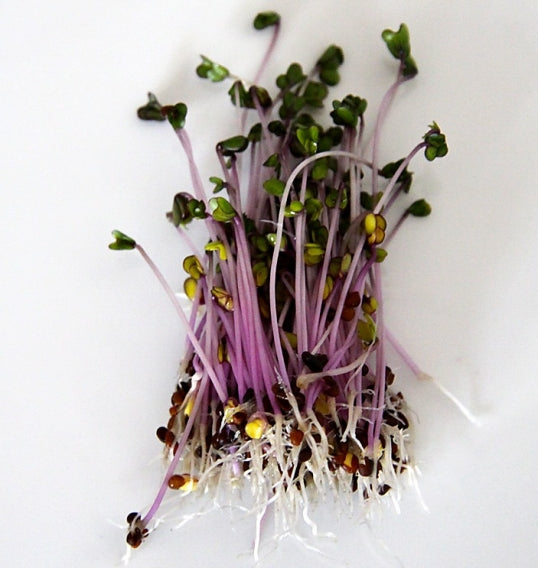Mama Bear's Bounty-Seeds and Sprouts
Cabbage, Red 75 G
Cabbage, Red 75 G
Couldn't load pickup availability
Red cabbage microgreens have many potential health benefits, including:
Heart health: May help lower cholesterol, reduce blood pressure, and improve blood vessel function
Anti-inflammatory: Contain phytonutrients that may reduce inflammation
Digestion: May help with constipation and improve digestion
Wound healing: May help wounds and damaged tissues heal
Nervous system: May help regulate the nervous system
Osteoporosis: May help prevent osteoporosis
Chronic disease: May help protect against chronic diseases like cardiovascular disease
Red cabbage microgreens are high in nutrients, including:
Dietary fiber: May help lower cholesterol and reduce the risk of heart disease
Vitamin C: May help improve endothelial function, which regulates blood flow
Anthocyanins: May help reduce blood pressure and improve blood vessel function
Vitamin E: Contain over 40 times the vitamin E content of mature red cabbage
Beta carotene: Contain high concentrations of beta carotene
Vitamin K: Contain high levels of vitamin K
Uses
You can use red cabbage microgreens in smoothies, sauces, soups, or as a seasoning or topping/garnish
How microgreens are beneficial
Microgreens are the seedlings of edible vegetables and herbs. They are more concentrated in nutrients than full-grown vegetables.
Grow red cabbage sprouts or microgreens!
- Days to Sprout: 5 day sprouts, 10-12 day microgreens
- Soak Time: 4-6 hours
- Yield: 1 tbsp of dry seed yields approximately 1 cup of sprouts
- Storage: Our seeds should sprout well for a year after you purchase them, if stored in a cool dry place. If you’d like to extend the germination life of your seeds, store them in the fridge. If you store your seeds in the freezer, they’ll last even longer!
Sprouting Directions
Soak: Put 1-2 Tbsp. seed in a wide mouth jar with a sprouting lid. Add water, swirl, and drain. Refill jar with water and soak 1-2 hours. (Soaking cabbage for longer than 2 hours can cause it to lose germination.) Drain well and invert jar at an angle on a sprouting rack, or in a bowl or drain rack
TIP: After draining, tap the shake the jar gently to remove excess moisture. Rotate the jar and tap gently a few more times.
Rinse: Twice a day, refill jar with cold water, swirl, and drain well by tapping excess water from jar.
Enjoy! Ready to eat in 5 days. Refrigerate to store. (Sprouts store best when they are fairly dry. If you need to store immediately after rinsing, spin dry first.)
Helpful tips:
- Some sprouts tend to clump together as they grow. To separate, fill the jar with water, remove the screen and stir gently with a fork during the regular rinse. Remove hulls if desired. Drain well as usual.
- The drier they are the better sprouts keep. Be sure to let sprouts grow another half day after the final sorting rinse before storing in the fridge. Optional: put folded paper towel on top of the sprouts in the jar. Put lid on and refrigerate turned upside down. This removes excess moisture.
- If your home is very warm during the summer months, it may help to rinse the sprouts three times a day with cold water. Stir gently if clumping.
- To remove the hulls and unsprouted seeds from leafy sprouts, use a special sorting rinse. Pull sprouts out of the jar into a large bowl filled with water. Swish gently using fingers to separate the tangled roots. Most hulls will separate and rise or sink. Discard the hulls. Collect the sprouts back to the jar with or without aid of a strainer. Return the sprouting closure and drain so you can continue for half a day more of sprouting.
- Some brassicas (cabbage family) like radish and broccoli develop very fuzzy root hairs the longer you leave them undisturbed and these can be mistaken for mould. You will even see these after a few days of storage in the fridge. Stirring and rinsing removes the root hairs for a time.


